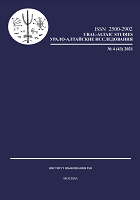СТИХИ И ПИСЬМА ЯКОВА ЕМЕЛЬЯНОВА КАК ИСТОЧНИК ДЛЯ ИЗУЧЕНИЯ ЯЗЫКОВОЙ НОРМЫ ТАТАР-КРЯШЕН XIX ВЕКА
USING YAKOV EMELYANOV’S POEMS AND LETTERS AS A LANGUAGE NORM FOR 19th CENTURY KRYASHEN TATARS
Author(s): Fanuza Sh. Nurieva, Gulnaz N. FakhretdinovaSubject(s): Christian Theology and Religion, Phonetics / Phonology, Morphology, Lexis, Historical Linguistics, 19th Century, Turkic languages
Published by: Институт языкознания Российской академии наук
Keywords: Yakov Emelyanov; Tatar language; Christianized Tatars; 19th century; poems; Zakazan subdialects;
Summary/Abstract: The article analyzes the language features of Yakov Emelyanov’s collection of “Poems in the Christianized-Tatar language”, published in 1879 for Baptized Tatars. Written manuscripts are one of the main sources for studying the history of the language, however, this collection has not yet been considered. The article analyzes the phonetic, morphological, and lexical features in the text. The language of the poems is compared with the linguistic material of the translated liturgical Cyrillic books, the Tatar literary language and its modem dialects. The results suggest that there are a number of graphic and phonetic features, including rounded vowels, the use of diphthongs and certain vowels and consonants in accordance with the literary variants, and the vowel deletion. The morphological features include the affix -ym, -em instead of the literary first person singular of the future tense with -r, the infinitive -maga affix instead of the literary -rga, as well as lexical peculiarities that distinguish the poems language from the modem Tatar literary language and some of its dialects. Moreover, all of them are recorded in the Mamadysh and Laishev dialects of the Tatar language, the regions where the poet was bom and lived. Thus, we can assume that forms of real colloquial words of that time are presented in Yakov Yemelyanov’s poems, and in translated liturgical books, these features were leveled. Analysis of the poems allows observing the history of the Tatar language and its dialects.
Journal: Урало-алтайские исследования
- Issue Year: 2021
- Issue No: 04 (43)
- Page Range: 106-123
- Page Count: 18
- Language: Russian

